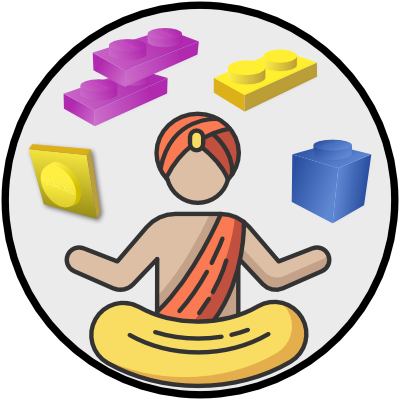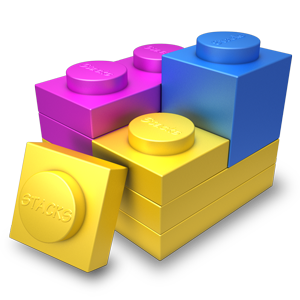About Stacks Guru
Stacks Guru is born from the need to search the vast number of videos out there on stacks built for Stacks Pro and the Stacks 5 plugin for Rapidweaver.
We have scraped over 500 videos to get the transcripts for each in order to make the spoken word searchable.
Please use this free tool to help you learn and discover the awesome power that Stacks and the stacks made for Stacks have to offer.
Leave a Tip!
Every little bit helps to keep this going. I'll be doing my very best to keep up with the likes of Joe when it comes all the videos he posts!

Dynamic Responsive Pictures with Foundation 6 Stacks
You can download the Retrobatch automation that was used inside this video at https://www.weavers.space/stacks/foun...You can download the Retrobatch automation that was used inside this video at https://www.weavers.space/stacks/foun...
Transcript
0:09 okay so responsive sizing how can we
0:11 define multiple images so we can display
0:14 different images to face on the size of
0:17 the browser so you notice at the very
0:19 top of the picture stack we have a
0:20 little plus button and if we click on
0:22 that you'll notice that there's two
0:23 different options I'm gonna I mean we're
0:26 gonna look at warehouse really quick but
0:28 we're gonna use drag and drop for the
0:30 rest of this video so let's look at what
0:32 warehouse gives us if you click on
0:34 warehouse you'll notice that you can
0:35 define just like the normal picture
0:37 stack on an image and a retina image and
0:41 again the if you don't define a retina
0:43 image it won't be used but it definitely
0:46 recommended you to supply both then you
0:48 supply the type of image so if if this
0:51 is a gif or an SVG or our web P or even
0:54 an mp4 right this is really cool so if
0:57 you haven't actually an mp4 file um that
1:00 has no audio you can actually insert it
1:03 onto the page using the picture stack um
1:05 as an alternative so that's really cool
1:07 uh and then below we have a media query
1:10 and this allows us to define where this
1:14 image is going to be used so is it gonna
1:16 be used on medium screen devices large
1:18 screen devices oh you know a certain
1:20 aspect ratio will it be used in portrait
1:24 mode so if you want to display a
1:25 different image um when a device is in
1:28 portrait mode you can do that you can
1:31 target dark mode and then you can also
1:33 per target prefers reduced motion and
1:37 this is useful for it if you're actually
1:39 are supplying an mp4 um if you define
1:44 you can also define a JPEG fallback if a
1:48 person prefers reduced motion or if you
1:51 you can supply a gif or offer a static
1:54 version if in someone's browser they
1:57 prefer reduced motion right this the
1:59 ability to kind of be nice to your user
2:01 so that if they actually prefer um you
2:04 know to save on bandwidth um this option
2:08 will serve up a static image rather than
2:10 something like a gif or an mp4
2:12 and last but not least if you're a super
2:15 uber geek you can do a custom media
2:17 query and do something slick there okay
2:21 so the rest of this video we're going to
2:23 be looking at drag and drop just because
2:25 it's a little bit simpler
2:27 okay then me worrying about copying and
2:30 pasting URLs from my server okay so here
2:34 we are
2:35 I can then inside here I'm going to drag
2:38 and drop a couple images
2:40 so here I've set up a picture stack so
2:42 that we have different images on small
2:44 medium and large devices so when you are
2:48 using on the actual default picture
2:50 stack level we're gonna actually define
2:53 these small images these are they're
2:55 going to be the images that we define on
2:56 mobile devices okay and then if we click
3:00 on our various rules that I added
3:02 so here I've added a large rule so if we
3:05 click on this will notice that I have
3:07 added two images that are going to be
3:09 used for large devices a non retina and
3:12 retina version and then I set the media
3:15 query to be large and then I added
3:17 another size here for medium and then
3:22 ice plotted my eye supplied the medium
3:24 image and medium retina images now you
3:28 might be thinking that's a lot of images
3:30 that is six different images that we
3:32 need to now create four different sizes
3:35 right yes it is um so what are some
3:38 ideas that we could do you know that's a
3:40 lot of work what can we do to speed that
3:42 process up a little bit so I don't want
3:45 to make this entire video a sales or an
3:48 image optimization video but I just want
3:52 to give you a small tip so he right here
3:54 was the main image that I had for this
3:57 image right very large image
3:59 I just got it off Adobe stock right um
4:02 basically I used an app called retro
4:05 batch now there's a lot of really great
4:08 apps out there but retro package is a
4:10 really cool one and it basically allows
4:13 me to create this workflow where
4:15 essentially I could say run and it asked
4:18 me what images I want I click on that
4:20 image and I say load images and what it
4:23 does is it automatically creates all of
4:26 these images for me in for in about five
4:29 seconds right um really really cool
4:33 now one thing it doesn't isn't fantastic
4:36 on is optimization so if you look here I
4:39 actually ran it through three of my
4:41 favorite image optimization programs
4:45 um image Optim image shrinker and JPEG
4:49 mini now again I'm not gonna make this
4:52 entire video all about image
4:54 optimization for this particular image
4:57 image drinker wins big-time right if you
5:01 notice here like though our largest
5:03 image is going to be the large retina
5:06 image this particular one is 3000 pixels
5:09 wide eye and image shrinker gets it down
5:12 to 620 kilobytes Wow blow your mind
5:15 um image optimistic and JPEG mini gets
5:20 it down to you know 1.2 right but an
5:22 image trigger for this particular image
5:25 is the winner um you know you kind of
5:28 learn over time which of these three
5:31 apps will do better on particular images
5:34 image shrinker for this particular image
5:36 wins hands down and it will win for a
5:38 lot of JPEG images I'll make sure if you
5:42 want to check out retro batch its from
5:44 flying meat um I will make this
5:46 particular workflow available um and you
5:49 know you just basically go through here
5:51 and the scale set the sizes that you
5:52 want for each um you know here I said if
5:55 we're kind of like a good
5:57 you know hero header sort of image this
5:59 is three thousand pixels two thousand
6:01 fifteen hundred twelve hundred a
6:02 thousand and six hundred right so um
6:05 adjust these sizes for the size image
6:08 you need please do that don't you don't
6:11 want to have a three thousand scaled
6:13 image for something that's only going to
6:15 be a small portion of your webpage right
6:16 so you're gonna have to modify these
6:18 values a little bit but um great app
6:22 okay so back to the pitcher stack um
6:24 you'll notice that if you want to just
6:26 keep adding you can add as many
6:28 conditions as you want um in here and
6:31 then just drag and drop the images in so
6:33 if you wanted to supply a special one
6:34 for dark mode and stuff like that you
6:36 can just add on as many conditions as
6:38 you want
6:39 now the key of this the order is very
6:41 important for these rules essentially
6:44 what it does is it it does the first one
6:47 that matches its rule wins so if we are
6:51 on a desktop device it'll come through
6:54 the top and go hey I'm a desktop
6:58 I'm large boom this first rule matches
7:01 me cool I'm gonna go and find the image
7:04 or retina image that I needs okay let's
7:07 say we're on an iPad it's gonna go
7:09 through and say it's gonna hit this
7:11 first condition which is large and say
7:12 nope I'm not large I'm gonna keep going
7:15 minimum device with 640 pixels Hey
7:18 that's me okay that means I'm gonna then
7:22 use these images and essentially um the
7:25 default image that you add to the main
7:27 picture stack is your default catch-all
7:29 image okay which is should be your small
7:32 device so if the iPhone comes in it's
7:35 gonna say okay cool
7:37 I'm not item not 1200 and you know I'm
7:39 not a thousand pixels
7:40 I'm not 640 pixels boom I'm gonna go
7:43 ahead and use the default image that's
7:45 despite it that's supplied in the in the
7:47 picture stack so hopefully these these
7:49 rules are very important to order um so
7:53 the topmost rule that it finds wins
8:02 [Music]
8:05 you"}]
0:11 define multiple images so we can display
0:14 different images to face on the size of
0:17 the browser so you notice at the very
0:19 top of the picture stack we have a
0:20 little plus button and if we click on
0:22 that you'll notice that there's two
0:23 different options I'm gonna I mean we're
0:26 gonna look at warehouse really quick but
0:28 we're gonna use drag and drop for the
0:30 rest of this video so let's look at what
0:32 warehouse gives us if you click on
0:34 warehouse you'll notice that you can
0:35 define just like the normal picture
0:37 stack on an image and a retina image and
0:41 again the if you don't define a retina
0:43 image it won't be used but it definitely
0:46 recommended you to supply both then you
0:48 supply the type of image so if if this
0:51 is a gif or an SVG or our web P or even
0:54 an mp4 right this is really cool so if
0:57 you haven't actually an mp4 file um that
1:00 has no audio you can actually insert it
1:03 onto the page using the picture stack um
1:05 as an alternative so that's really cool
1:07 uh and then below we have a media query
1:10 and this allows us to define where this
1:14 image is going to be used so is it gonna
1:16 be used on medium screen devices large
1:18 screen devices oh you know a certain
1:20 aspect ratio will it be used in portrait
1:24 mode so if you want to display a
1:25 different image um when a device is in
1:28 portrait mode you can do that you can
1:31 target dark mode and then you can also
1:33 per target prefers reduced motion and
1:37 this is useful for it if you're actually
1:39 are supplying an mp4 um if you define
1:44 you can also define a JPEG fallback if a
1:48 person prefers reduced motion or if you
1:51 you can supply a gif or offer a static
1:54 version if in someone's browser they
1:57 prefer reduced motion right this the
1:59 ability to kind of be nice to your user
2:01 so that if they actually prefer um you
2:04 know to save on bandwidth um this option
2:08 will serve up a static image rather than
2:10 something like a gif or an mp4
2:12 and last but not least if you're a super
2:15 uber geek you can do a custom media
2:17 query and do something slick there okay
2:21 so the rest of this video we're going to
2:23 be looking at drag and drop just because
2:25 it's a little bit simpler
2:27 okay then me worrying about copying and
2:30 pasting URLs from my server okay so here
2:34 we are
2:35 I can then inside here I'm going to drag
2:38 and drop a couple images
2:40 so here I've set up a picture stack so
2:42 that we have different images on small
2:44 medium and large devices so when you are
2:48 using on the actual default picture
2:50 stack level we're gonna actually define
2:53 these small images these are they're
2:55 going to be the images that we define on
2:56 mobile devices okay and then if we click
3:00 on our various rules that I added
3:02 so here I've added a large rule so if we
3:05 click on this will notice that I have
3:07 added two images that are going to be
3:09 used for large devices a non retina and
3:12 retina version and then I set the media
3:15 query to be large and then I added
3:17 another size here for medium and then
3:22 ice plotted my eye supplied the medium
3:24 image and medium retina images now you
3:28 might be thinking that's a lot of images
3:30 that is six different images that we
3:32 need to now create four different sizes
3:35 right yes it is um so what are some
3:38 ideas that we could do you know that's a
3:40 lot of work what can we do to speed that
3:42 process up a little bit so I don't want
3:45 to make this entire video a sales or an
3:48 image optimization video but I just want
3:52 to give you a small tip so he right here
3:54 was the main image that I had for this
3:57 image right very large image
3:59 I just got it off Adobe stock right um
4:02 basically I used an app called retro
4:05 batch now there's a lot of really great
4:08 apps out there but retro package is a
4:10 really cool one and it basically allows
4:13 me to create this workflow where
4:15 essentially I could say run and it asked
4:18 me what images I want I click on that
4:20 image and I say load images and what it
4:23 does is it automatically creates all of
4:26 these images for me in for in about five
4:29 seconds right um really really cool
4:33 now one thing it doesn't isn't fantastic
4:36 on is optimization so if you look here I
4:39 actually ran it through three of my
4:41 favorite image optimization programs
4:45 um image Optim image shrinker and JPEG
4:49 mini now again I'm not gonna make this
4:52 entire video all about image
4:54 optimization for this particular image
4:57 image drinker wins big-time right if you
5:01 notice here like though our largest
5:03 image is going to be the large retina
5:06 image this particular one is 3000 pixels
5:09 wide eye and image shrinker gets it down
5:12 to 620 kilobytes Wow blow your mind
5:15 um image optimistic and JPEG mini gets
5:20 it down to you know 1.2 right but an
5:22 image trigger for this particular image
5:25 is the winner um you know you kind of
5:28 learn over time which of these three
5:31 apps will do better on particular images
5:34 image shrinker for this particular image
5:36 wins hands down and it will win for a
5:38 lot of JPEG images I'll make sure if you
5:42 want to check out retro batch its from
5:44 flying meat um I will make this
5:46 particular workflow available um and you
5:49 know you just basically go through here
5:51 and the scale set the sizes that you
5:52 want for each um you know here I said if
5:55 we're kind of like a good
5:57 you know hero header sort of image this
5:59 is three thousand pixels two thousand
6:01 fifteen hundred twelve hundred a
6:02 thousand and six hundred right so um
6:05 adjust these sizes for the size image
6:08 you need please do that don't you don't
6:11 want to have a three thousand scaled
6:13 image for something that's only going to
6:15 be a small portion of your webpage right
6:16 so you're gonna have to modify these
6:18 values a little bit but um great app
6:22 okay so back to the pitcher stack um
6:24 you'll notice that if you want to just
6:26 keep adding you can add as many
6:28 conditions as you want um in here and
6:31 then just drag and drop the images in so
6:33 if you wanted to supply a special one
6:34 for dark mode and stuff like that you
6:36 can just add on as many conditions as
6:38 you want
6:39 now the key of this the order is very
6:41 important for these rules essentially
6:44 what it does is it it does the first one
6:47 that matches its rule wins so if we are
6:51 on a desktop device it'll come through
6:54 the top and go hey I'm a desktop
6:58 I'm large boom this first rule matches
7:01 me cool I'm gonna go and find the image
7:04 or retina image that I needs okay let's
7:07 say we're on an iPad it's gonna go
7:09 through and say it's gonna hit this
7:11 first condition which is large and say
7:12 nope I'm not large I'm gonna keep going
7:15 minimum device with 640 pixels Hey
7:18 that's me okay that means I'm gonna then
7:22 use these images and essentially um the
7:25 default image that you add to the main
7:27 picture stack is your default catch-all
7:29 image okay which is should be your small
7:32 device so if the iPhone comes in it's
7:35 gonna say okay cool
7:37 I'm not item not 1200 and you know I'm
7:39 not a thousand pixels
7:40 I'm not 640 pixels boom I'm gonna go
7:43 ahead and use the default image that's
7:45 despite it that's supplied in the in the
7:47 picture stack so hopefully these these
7:49 rules are very important to order um so
7:53 the topmost rule that it finds wins
8:02 [Music]
8:05 you"}]
Search the page
0
{name}
{rating}
{comment}



